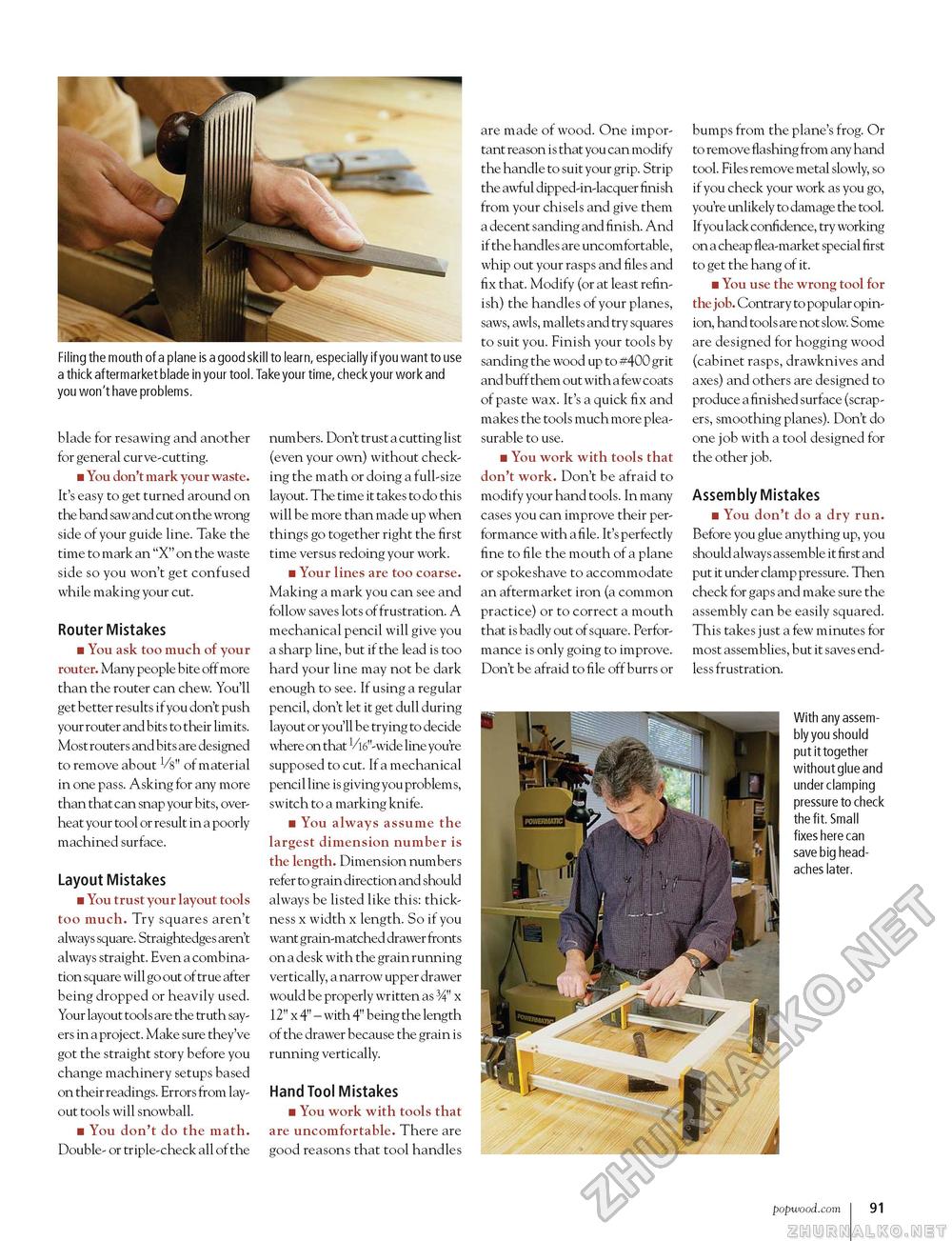Popular Woodworking 2004-11 № 144, страница 92
Filing the mouth of a plane is a good skill to learn, especially if you want to use a thick aftermarket blade in your tool. Take your time, check your work and you won't have problems. blade for resawing and another for general curve-cutting. ■ You don't mark your waste. It's easy to get turned around on the band saw and cut on the wrong side of your guide line. Take the time to mark an "X" on the waste side so you won't get confused while making your cut. Router Mistakes ■ You ask too much of your router. Many people bite off more than the router can chew. You'll get better results if you don't push your router and bits to their limits. Most routers and bits are designed to remove about Vs" of material in one pass. Asking for any more than that can snap your bits, overheat your tool or result in a poorly machined surface. Layout Mistakes ■ You trust your layout tools too much. Try squares aren't always square. Straightedges aren't always straight. Even a combination square will go out of true after being dropped or heavily used. Your layout tools are the truth say-ers in a project. Make sure they've got the straight story before you change machinery setups based on their readings. Errors from layout tools will snowball. ■ You don't do the math. Double- or triple-check all of the numbers. Don't trust a cutting list (even your own) without checking the math or doing a full-size layout. The time it takes to do this will be more than made up when things go together right the first time versus redoing your work. ■ Your lines are too coarse. Making a mark you can see and follow saves lots of frustration. A mechanical pencil will give you a sharp line, but if the lead is too hard your line may not be dark enough to see. If using a regular pencil, don't let it get dull during layout or you'll be trying to decide where on that 1/l6"-wide line you're supposed to cut. If a mechanical pencil line is giving you problems, switch to a marking knife. ■ You always assume the largest dimension number is the length. Dimension numbers refer to grain direction and should always be listed like this: thickness x width x length. So if you want grain-matched drawer fronts on a desk with the grain running vertically, a narrow upper drawer would be properly written as W" x 12" x 4" - with 4" being the length of the drawer because the grain is running vertically. Hand Tool Mistakes ■ You work with tools that are uncomfortable. There are good reasons that tool handles are made of wood. One important reason is that you can modify the handle to suit your grip. Strip the awful dipped-in-lacquer finish from your chisels and give them a decent sanding and finish. And if the handles are uncomfortable, whip out your rasps and files and fix that. Modify (or at least refin-ish) the handles of your planes, saws, awls, mallets and try squares to suit you. Finish your tools by sanding the wood up to #400 grit and buff them out with a few coats of paste wax. It's a quick fix and makes the tools much more pleasurable to use. ■ You work with tools that don't work. Don't be afraid to modify your hand tools. In many cases you can improve their performance with a file. It's perfectly fine to file the mouth of a plane or spokeshave to accommodate an aftermarket iron (a common practice) or to correct a mouth that is badly out of square. Performance is only going to improve. Don't be afraid to file off burrs or bumps from the plane's frog. Or to remove flashing from any hand tool. Files remove metal slowly, so if you check your work as you go, you're unlikely to damage the tool. If you lack confidence, try working on a cheap flea-market special first to get the hang of it. ■ You use the wrong tool for the job. Contrary to popular opinion, hand tools are not slow. Some are designed for hogging wood (cabinet rasps, drawknives and axes) and others are designed to produce a finished surface (scrapers, smoothing planes). Don't do one job with a tool designed for the other job. Assembly Mistakes ■ You don't do a dry run. Before you glue anything up, you should always assemble it first and put it under clamp pressure. Then check for gaps and make sure the assembly can be easily squared. This takes just a few minutes for most assemblies, but it saves endless frustration. With any assembly you should put it together without glue and under clamping pressure to check the fit. Small fixes here can save big headaches later. popwood.com 91 |








